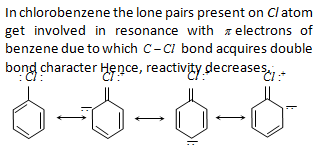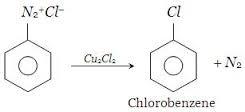12th Grade > Chemistry
HALOALKANES AND HALOARENES MCQs
Total Questions : 30
| Page 2 of 3 pages
Answer: Option B. -> CH3Cl, CH3F, CH3Br
:
B
Dipole moment decreases with decrease in electronegativity of halogen. Fluorides have lower dipole moment than chlorides because of smaller C-F bond length which outweights the effect of greater electronegativity
:
B
Dipole moment decreases with decrease in electronegativity of halogen. Fluorides have lower dipole moment than chlorides because of smaller C-F bond length which outweights the effect of greater electronegativity
Answer: Option A. -> (CH3)3CD
:
A
(CH3)3C - MgCl + D2O → (CH3)3C - D + Mg(OD)Cl
:
A
(CH3)3C - MgCl + D2O → (CH3)3C - D + Mg(OD)Cl
Answer: Option D. -> Pyridine
:
D
Pyridine molecule act as a catalyst which is used to neutralise HCl formed.Pyridine also acts as a nucleophile because in the reaction proton is added to alcoholic O due to strong electronegative
SOCl2 group and proton is removed by pyridine and reforms S=O and Cl- is removed from SOCl2.This Cl- ion reacts with electrophilic C atom of alcohol and displaces SO2 and another releases another Cl-
Ion which makes alkyl chloride.
:
D
Pyridine molecule act as a catalyst which is used to neutralise HCl formed.Pyridine also acts as a nucleophile because in the reaction proton is added to alcoholic O due to strong electronegative
SOCl2 group and proton is removed by pyridine and reforms S=O and Cl- is removed from SOCl2.This Cl- ion reacts with electrophilic C atom of alcohol and displaces SO2 and another releases another Cl-
Ion which makes alkyl chloride.



















